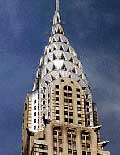
 Art Deco
or
art deco - An art
movement involving a mix of modern
decorative art styles, largely of the 1920s and 1930s,
whose main characteristics were derived from various avant-garde
painting styles of the early
twentieth century. Art deco works exhibit aspects of Cubism,
Russian Constructivism and
Italian Futurism
— with abstraction, distortion,
and simplification, particularly
geometric shapes
and highly intense
colors — celebrating the rise
of commerce, technology,
and speed.
Art Deco
or
art deco - An art
movement involving a mix of modern
decorative art styles, largely of the 1920s and 1930s,
whose main characteristics were derived from various avant-garde
painting styles of the early
twentieth century. Art deco works exhibit aspects of Cubism,
Russian Constructivism and
Italian Futurism
— with abstraction, distortion,
and simplification, particularly
geometric shapes
and highly intense
colors — celebrating the rise
of commerce, technology,
and speed.
The growing impact of the machine can be seen in repeating and overlapping images from 1925; and in the 1930s, in streamlined forms derived from the principles of aerodynamics.
The name came from the 1925 Exposition Internationale des Arts Decoratifs Industriels et Modernes, held in Paris, which celebrated living in the modern world.
It was popularly considered to be an elegant style of cool sophistication in architecture and applied arts which range from luxurious objects made from exotic material to mass produced, streamlined items available to a growing middle class.
Examples:

Designed by Poiret (French), manufactured
by La Maison Martine, French, Textile Sample, c. 1923, silk, 90 x 34
inches (228.6 x 86.4 cm), Metropolitan Museum of Art, NY. See
textile.

Seraphin Soudbinine (French, 1870-1944),
designer, Jean Dunand (French, 1877-1942), designer, "Fortissimo" Screen, 1925-26,
lacquered wood;
each panel: 98 x 35 inches (246.9 x 89.9 cm), Metropolitan Museum
of Art, NY. See screen.
Émile-Jacques Ruhlmann (French, 1879-1933)

Raymond Hood, architect (American, 1881-1934), Daily News Building, 1930, New York.

William Van Alen (American, 1882-1954), Chrysler
Building, 1930, New York City. An archetypal
American Art Deco skyscraper, the exterior of the building reflects
the Chrysler automobile. The building was faced
with Nirosta stainless
steel, because
 of its low-maintenance,
and the beauty of its color.
of its low-maintenance,
and the beauty of its color.
Part of the surface
decorations include sculptural ornaments
comparable to gargoyles
and hood ornaments.
 The
radiating curves on the building's dome
mimic giant sunbeams, a popular Art Deco theme.
The
radiating curves on the building's dome
mimic giant sunbeams, a popular Art Deco theme.
In the lobby of the Chrysler Building are
more Art Deco designs. The outer doors for each elevator are decorated with
stylized papyrus motif decor of exotic "Metyl-Wood"
veneers produced by the
Tyler Company, 1928-1930.
John Storrs (American, 1885-1956).

Paul Manship (American, 1886-1966), Dancer and Gazelles, 1916, bronze, .826 x .883 x .285 m (32 1/2
x 34 3/4 x 11 1/4 inches), National Gallery of Art, Washington,
DC.

Paul Manship, Atalanta, 1921, bronze, height
28 3/4 inches (73.1 cm), Smithsonian American Art Museum, Washington,
D.C.

Paul Manship, Actaeon (#1), 1925, bronze, National Museum of American
Art, Washington, D.C.

Paul Manship, Indian Hunter with his Dog, 1926, bronze on marble base,
height 23 3/4 inches, Dayton
Art Institute, OH.


Paul Manship, Prometheus, 1934, gilt
bronze, height 18 feet, weight
8 tons, plaza of Rockefeller Center, NY. Its companion piece
is Atlas. See Prometheus.
Kem Weber (German-American designer, 1889-1963), "Zephyr" Digital Clock Model No. 304-P40, 1934, lacquered copper, chrome-plated brass, and plastic, 3 3/4 x 3 3/4 x 3 3/4 inches (9.5 x 9.5 x 9.5 cm), manufactured by Lawson Time Inc., Los Angeles. This streamlined object is both elegant and utilitarian. Kem Weber said his approach to design was "to make the practical more beautiful and the beautiful more practical."
C. Paul Jennewein (German-American, 1890-1978), Greek Dance, 1984, (surmoulage from the original bronze created in 1926), gilt bronze, height 17 inches, Tampa Museum of Art, FL. See dance.

Louis Lozowick (1892-1973), New York City (Brooklyn Bridge), 1923, lithograph.

Grant Wood (American, 1892-1942), American
Gothic, 1930, oil on
beaver board, 74.3 x 62.4 cm, Art Institute of Chicago. See American Scene painting and American Gothic.

Grant Wood, The Ride of Paul Revere, 1931, oil
on Masonite, 30 x 40
inches (76.2 x 101.6 cm), Metropolitan Museum of Art, NY. See
history
painting.
Grant Wood, Daughters of Revolution, 1932, Cincinnati Art Museum. Daughters of Revolution is a satirical image of three smug ladies who revel in what they think is their true "Americanness." Wood has painted them drinking from Chinese teacups, wearing lace made in Italy, in front of the painting Washington Crossing the Delaware by the German-American artist Emanual Leutze. See history painting.

Tamara de Lempicka (born in Poland, from
the age of 20, active in Paris and America, 1898-1980), Self-Portrait
in the Green Bugatti, 1925, oil
on wood panel,
private collection. See Polish art.
![]()

Tamara de Lempicka, Spring, 1928, oil
on wood panel,
private collection.

Tamara de Lempicka, Adam and Eve, c. 1932, oil,
Petit Palais, Geneva, Switzerland. See Tamara de Lempicka's studio, c. 1931.
![]()

Tamara de Lempicka, Sleeping Woman, 1935, oil
on canvas, private collection.

Tamara de Lempicka, Calla Lilies, 1941, oil,
private collection, CA. See curvilinear.
Wallace Harrison (American), 1939 World's Fair: perisphere and trilon, 1939.
Henry Hohauser (American architect) Collins Park Hotel, 1939, one of the many Art Deco buildings in Miami Beach, FL. The building's circular entry is dramatized by strikingly vertical columns, vivid colors, and patterns employing a chevron motif.
![]()
Also see Arts and Crafts Movement.
https://inform.quest/_art
Copyright © 1996-![]()